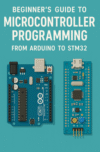In the world of embedded systems, components need to talk to each other. Microcontrollers exchange data with sensors, displays, memory chips, and other devices using communication protocols. Among the most common are UART, SPI, and I2C. Understanding these will help you choose the right one for your project and troubleshoot problems effectively.
1. UART (Universal Asynchronous Receiver/Transmitter)
- How it works: Sends data as a stream of bits over two lines (TX and RX) without a shared clock.
- Pros: Simple to use, widely supported, point-to-point communication.
- Cons: Limited to two devices; requires matched baud rates.
- Common uses: Serial consoles, GPS modules, Bluetooth modules.
2. SPI (Serial Peripheral Interface)
- How it works: Uses a master-slave architecture with separate lines for data in (MISO), data out (MOSI), clock (SCK), and chip select (CS).
- Pros: Very fast, supports multiple slaves, full-duplex communication.
- Cons: Requires more pins; each device needs its own CS line.
- Common uses: High-speed sensors, displays, SD cards.
3. I2C (Inter-Integrated Circuit)
- How it works: Uses two lines (SDA for data, SCL for clock) to connect multiple devices with unique addresses.
- Pros: Only two wires for many devices; simple wiring.
- Cons: Slower than SPI; less robust for long distances.
- Common uses: Sensor arrays, configuration chips, low-speed peripherals.
4. Choosing the Right Protocol
- Need simplicity? Use UART.
- Need speed and performance? Use SPI.
- Need multiple devices with minimal wiring? Use I2C.
Final Thoughts Each protocol has its niche. Mastering them ensures efficient communication in your embedded projects, whether you’re logging environmental data, streaming video from a camera, or building a smart home controller.



